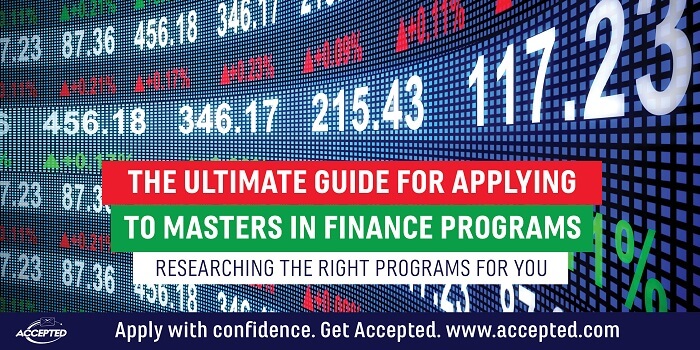Researching the Right Masters in Finance Programs for You

You want a Masters in Finance. And you know that finding the right ones to apply to will take some work, some research. Well, the web makes that research easy, right?
Sort of. You’ll certainly find a lot of programs and lots of info about those programs online. But how do you plan your search productively (given your limited time)? How do you organize your findings in a meaningful way so you can compare programs?
Here is a brief guide to help you make this research process productive, efficient, and even (hopefully) enjoyable.
Common Elements of All Masters in Finance Programs
All MFin programs have the following features:
- They are practical in purpose; their curriculums are meant to provide applicable learning.
- Recruiting is an important element and focus, for both you and the program (if their graduates do not obtain jobs, it reflects poorly on the programs).
- Networking opportunities likewise are a major benefit of all such programs; the connections you will gain can last a lifetime and will represent diverse segments within the finance industry.
- Most meet STEM requirements for U.S. OPT visa extensions.
Area of Difference: Curriculum
I DID just say they’re alike in their practical bent. But how they deliver that practical learning differs.
Many, if not most, offer core courses plus some tracks for different areas of finance. For example:
- The MFin program at Ohio State’s Fisher College of Business offers four specializations: Investment Management, Corporate Finance, Risk Management, and Real Estate. The school specifically “encourages” you to pursue one.
- At the MFin program at the Olin Business School at Washington University, there are also four tracks: Corporate Finance and Investments, Wealth and Asset Management, Quantitative Finance, and Global Finance.
- At USC Marshall School of Business, there are a wide range of electives, but no set tracks; you develop your own path to specialization.
- In the London Business School Master of Financial Analysis MFA program (early career, as opposed to the LBS MFin which targets more experienced people), there is a curriculum component specifically on “personal and leadership development.”
What it means for you: Determine what kind of curriculum will best meet your needs and how much weight you want to give this factor and evaluate the programs accordingly.
Area of Difference: Career Services
I DID say that recruiting is important for all MFin programs. But how they prepare you for that recruiting differs. Most programs have not only interview training and resume preparation services, but also career exploration and counseling to determine your best path, along with tailored job-seeking strategies, etc. Other programs largely take what you bring to the table and help you polish it.
By the way, the best career services don’t help much if recruiters don’t represent industry segments you are interested in or regions you want to live in.
What it means for you: If you want extensive career services, prioritize programs that work with you from day one in this area. Also, you should examine the recent recruiting history at any program.
Area of Difference: Pedagogical Approach
While most programs use some mix of teaching methods, some veer strongly toward lecture or toward team projects. Some have frequent tests and quizzes, and some have a major project or option to do an independent thesis.
While all focus on finance topics, some contextualize them more with a holistic view of their role in businesses and organizations.
What it means for you: Know your learning style and preferences and seek out programs whose teaching methods align with them. It’s an often overlooked area.
Area of Difference: Special Opportunities
Some Masters in Finance programs provide special opportunities such as doing a thesis (like at MIT, for example). Other MFin programs give you access to the same clubs, research centers, etc. that MBA students enjoy, as well as the chance to TA for professors, etc. The LBS program cited above offers “global immersion field trips” which can be incredibly valuable at this early point in your career.
Some programs, such as MIT, offer both shorter and longer versions of their program, often with the option of a summer internship woven into the longer version. For example, you would take the 12-month MIT MFin program without an internship or the 18-month option with one.
What it means for you: A special opportunity can certainly make a big difference in your MFin experience if it’s the right one. Keep your eye out.
Good luck with your school search! And with the plethora of options to weigh, you might like some help with school selection – in which case contact us; it is a service we provide that can help you get off to the best possible start.
[xyz-ihs snippet=”GRAD–SR–Masters-Finance-Admissions”]
 Cindy Tokumitsu has advised hundreds of successful applicants, helping them gain acceptance to top MFin, MBA and EMBA, and other graduate management programs in her 15+ years with Accepted. She would love to help you too. Want Cindy to help you get Accepted? Click here to get in touch!
Cindy Tokumitsu has advised hundreds of successful applicants, helping them gain acceptance to top MFin, MBA and EMBA, and other graduate management programs in her 15+ years with Accepted. She would love to help you too. Want Cindy to help you get Accepted? Click here to get in touch!
Related Resources:
• Fitting In & Standing Out: the Paradox at the Heart of Admissions, a free guide
• MIT Sloan Master in Finance: How to Get In!, a podcast episode
• Focus on Fit, a podcast episode
